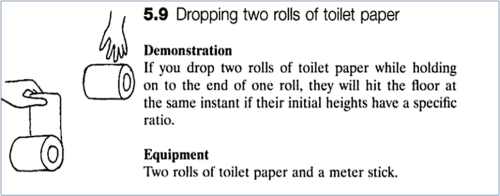In his Dec. 17 Action-Reaction blog post titled “Falling Rolls,” Frank Noschese details an exercise from Robert Ehrlich’s book Why Toast Lands Jelly-Side Down.
 The exercise, a rotational motion problem that challenges students to find the ratio of heights at which you can drop two identical toilet paper rolls, one dropped regularly, the other dropped by holding onto the end of the paper and letting it unroll, such that the two rolls hit the ground at the same time. It’s a terrific, easy-to-replicate and demonstrate problem that pulls together a great number of rotational motion skills –> finding the moment of inertia, applying the parallel-axis theorem, identifying forces and torques from free body diagrams, and converting angular acceleration to linear acceleration. My students dove into the challenge with zest last year, and we decided to repeat the exercise this year, working in groups of two or three to see who could derive the appropriate relationship most accurately.
The exercise, a rotational motion problem that challenges students to find the ratio of heights at which you can drop two identical toilet paper rolls, one dropped regularly, the other dropped by holding onto the end of the paper and letting it unroll, such that the two rolls hit the ground at the same time. It’s a terrific, easy-to-replicate and demonstrate problem that pulls together a great number of rotational motion skills –> finding the moment of inertia, applying the parallel-axis theorem, identifying forces and torques from free body diagrams, and converting angular acceleration to linear acceleration. My students dove into the challenge with zest last year, and we decided to repeat the exercise this year, working in groups of two or three to see who could derive the appropriate relationship most accurately.
To begin the exercise, we set our variables (H=height for dropped roll, h=height for unrolled roll, r = inner radius, R = outer radius), then identified the time it takes for the dropped roll to hit the ground using standard kinematics:
Next, we did the same thing for the unrolling toilet paper roll:
Of course, if we want them to hit at the same time, the times must be equal, therefore we can show:
Obviously, what we really need to focus our efforts on is finding the linear acceleration of the unrolling roll. To save ourselves some time, we started by looking up the moment of inertia for a cylinder:
Using the parallel-axis theorem to account for the unrolled roll rotating about its outer radius we find:
Next, we can use a free body diagram to identify the net torque on the roll as MgR, and use Newton’s 2nd Law for Rotational Motion to find the angular acceleration:
Since linear acceleration can be found from angular acceleration multiplied by the radius of rotation (R):
Finally, since we’re looking for the ratio of the dropped height to the unrolled height:
For a toilet paper roll of inner radius .009m and outer radius R=.0385m (our school rolls from the janitor supply closet):
Check out our high-speed video confirmations from 2010 (below)
and from 2011 (below)!
